It’s very rare to have an SQL query involving a single table. We may need to merge multiple tables by rows (records) or columns (fields) to get the desired result.
12 Ways to Merge Two Tables in SQL
- Inner Join
- Left Join
- Right Join
- Full Join
- Cross Join
- Semi Join
- Anti Join
- Self Join
- Union
- Union All
- Intersect
- Except
In this article, we’ll discuss the operators and commands in SQL that allow you to merge tables by rows or columns.
12 SQL Merge Two Tables Methods
You can merge two tables in SQL either by columns or by rows to better understand data. Each utilizes different methods. Let’s look at both:
SQL Merge Two Tables By Columns
Multiple tables can be merged by columns in SQL using joins. Joins merge two tables based on the specified columns. Generally, the primary key of one table and a foreign key of the other. Below is the generic syntax for SQL joins.
SELECT
*
FROM table_1
JOIN table_2
USING (id);
In the above syntax, table_1 and table_2 are the two tables with the key column (matching column in both the tables), id. We use the keyword USING only when the key column has the same name in both the tables. Otherwise, we need to explicitly mention the key columns of both the tables as shown below.
SELECT
*
FROM table_1 t1
JOIN table_2 t2
ON t1.t1_id = t2.t2_id;In the above syntax, t1 is an alias of table_1 and t2 is of table_2. When the names of the key columns aren’t the same in both the tables, we need to match them using the ON keyword, as shown above. We’ll now discuss a few important joins in SQL.
Inner Join
INNER JOIN merges two tables by columns and returns only the matching records based on the specified columns in both the tables. In the below query result, we can see that only the records with common id in both left_table and right_table are returned.
SELECT
*
FROM left_table
INNER JOIN right_table
USING (id);Or
SELECT
*
FROM left_table l
INNER JOIN right_table r
ON l.id = r.id;
Left Join
LEFT JOIN merges two tables by columns and returns all the records in the left table but only the matching records based on the specified columns from the right table. In the below query result, we can see the records with common id in both the tables along with all the records of the left_table. Records in the right_table with no matching id in the left_table have NULL.
SELECT
*
FROM left_table
LEFT JOIN right_table
USING (id);
Or
SELECT
*
FROM left_table l
LEFT JOIN right_table r
ON l.id = r.id;

Right Join
RIGHT JOIN merges two tables by columns and returns all the records in the right table but only the matching records based on the specified columns from the left table. In the below query result, we can see the records with common id in both the tables along with all the records of the right_table. Records in the left_table with no matching idin the right_table have NULL.
SELECT
*
FROM left_table
RIGHT JOIN right_table
USING (id);
Or
SELECT
*
FROM left_table l
RIGHT JOIN right_table r
ON l.id = r.id;
Full Join
FULL JOIN can be considered as a combination of left and right joins. FULL JOIN merges two tables by columns and returns all the records in both the left and right tables. In the below query result, we can see that all the records of both the tables are returned. Records with no matching id in the other table have NULL.
SELECT
*
FROM left_table
FULL JOIN right_table
USING (id);
Or
SELECT
*
FROM left_table l
FULL JOIN right_table r
ON l.id = r.id;
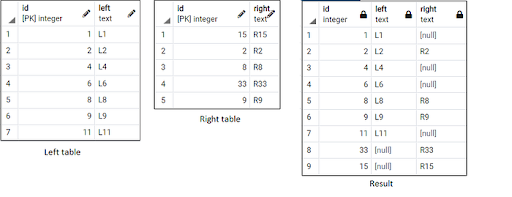
Cross Join
CROSS JOIN returns the cartesian product of two tables. The cartesian product of two sets: A = {1, 2}, B = {3, 4} is A x B = {(1, 3), (1, 4), (2, 3), (2, 4)}. We don’t need to specify a key column in cross joins.
SELECT
*
FROM left_table
CROSS JOIN right_table

Semi Join
SEMI JOIN is technically not an SQL join but works like a JOIN. SEMI JOIN returns the matching records in the left table based on a key column in the right table. It doesn’t include the columns of the right table in the query result. In the below example, we want to return the records from the left_table with matching id in the right_table. In other words, we want the records in the left_table, whose id is present in the right_table.
SELECT
*
FROM left_table
WHERE
id IN
(
SELECT id FROM right_table
)
Anti Join
ANTI JOIN is also technically not an SQL join but works like a join. ANTI JOIN returns the non-matching records in the left table based on a key column in the right table. It also doesn’t include the columns of the right table in the query result. In the below example, we want to return the records from the left_table whose id doesn’t match with the idof theright_table. In other words, we want the records in the left_table whose id is not present in the right_table.
SELECT
*
FROM left_table
WHERE
id
NOT IN
(
SELECT id FROM right_table
)

Self Join
SELF JOIN enables us to join a table with itself. In the below query, we need to find the records with the same left value. For this, we have joined the table with itself and filtered the records with the same left value but different id.
SELECT
*
FROM left_table l1, left_table l2
WHERE
l1.left = l2.left
AND
l1.id <> l2.id
ORDER BY l1.left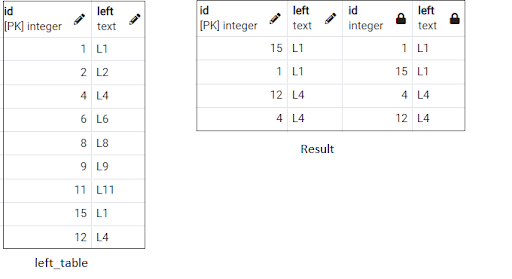
SQL Merge Two Tables by Rows
Union
UNION merges two tables by rows, provided the data types of the columns of one table matches with that of the other. We can’t merge a table having column data types as integer and text with a table having column data types as text and integer. However, we can merge two tables even if the column names of one table don’t match with that of the other. UNION returns only the unique records of both the tables.
(
SELECT
*
FROM left_table
)
UNION
(
SELECT
*
FROM right_table
)
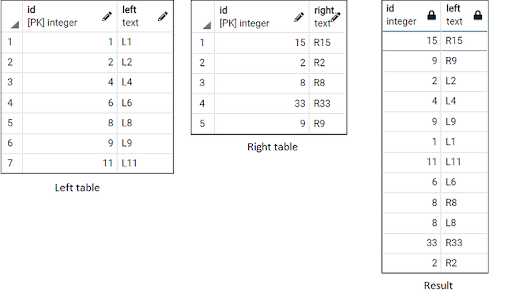
Union All
Similar to UNION, UNION ALL also merges tables by rows. Unlike UNION, UNION ALL retains the duplicate records of both the tables. In the below query result, we have merged the id of left_table and right_table. We can see a few duplicates in the result.
(
SELECT
id
FROM left_table
)
UNION ALL
(
SELECT
id
FROM right_table
)

Intersect
INTERSECT returns the common records of both the tables. In the below query result, we can see the common ids of left_table and right_table.
(
SELECT
id
FROM left_table
)
INTERSECT
(
SELECT
id
FROM right_table
)
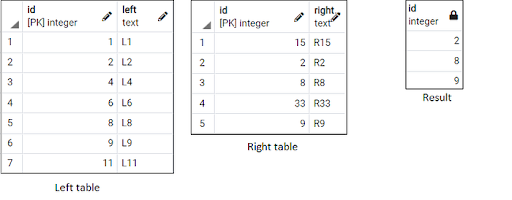
Except
EXCEPT returns the records from the first table (left table) which are not present in the second table (right table). In the below query result, we can see the ids of left_table, which aren’t present in the right_table.
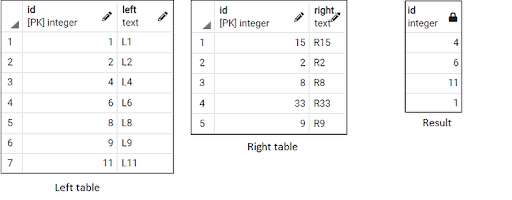
SQL Merge Two Tables Example Queries
We’ll use the dvd_rental database downloaded from here and restore it. Below is the documentation to restore a database in PostgreSQL.
1. Top 5 Frequent Renters
In this example, we need to find the top five customers who rented the most. For this, we’ll:
- Join the
customerandrentaltables usingcustomer_id. - Count the customers (as
rental_count) by groupingcustomer_id. - Sort the result according to
rental_countin descending order. - Limit the results to first five records.
SELECT
c.customer_id,
c.first_name,
c.last_name,
COUNT(c.customer_id) AS rental_count
FROM customer c
INNER JOIN rental r
USING (customer_id)
GROUP BY customer_id
ORDER BY
COUNT(c.customer_id) DESC
LIMIT 5;

2. Top and Bottom 5 Customers by Revenue Generated
In this example, we’ll use common table expressions (CTE). With CTEs, we can create temporary tables that exist for a particular query. Below is the official documentation on CTEs.
In this example, we need to find the top and bottom five customers who generated the most revenue. For this, we’ll:
First, create a CTE named revenue_per_customer by:
- Joining the
customerandrentaltables usingcustomer_id. - Joining the resultant table with
paymenttable usingrental_id. - Computing the total amount paid by customers for each rental transaction (as
total_amount) grouping bycustomer_id. - Finally, selecting the
customer_id,first_name,last_nameandtotal_amount.
Next, select the top five customers by revenue from the above CTE by:
- Sorting
total_amountin therevenue_per_customer(CTE result) in descending order. - Limiting the result to first five records.
- Adding a comment specifying the records as
‘Top 5’.
Then, select the bottom five customers by revenue from the above CTE by:
- Sorting
total_amountin therevenue_per_customer(CTE result) in ascending order. - Limiting the result to first five records.
- Adding a comment specifying the records as
‘Bottom 5’.
Finally, merge the results using UNION.
WITH revenue_per_customer AS
(SELECT
c.customer_id,
c.first_name,
c.last_name,
SUM(p.amount) AS "total_amount"
FROM customer c
INNER JOIN rental r
USING (customer_id)
INNER JOIN payment p
USING (rental_id)
GROUP BY c.customer_id)
(SELECT
*,
'Top 5' AS comment
FROM revenue_per_customer
ORDER BY total_amount DESC
LIMIT 5)
UNION
(SELECT
*,
'Bottom 5' AS comment
FROM revenue_per_customer
ORDER BY total_amount ASC
LIMIT 5)
ORDER BY comment DESC, total_amount DESC;
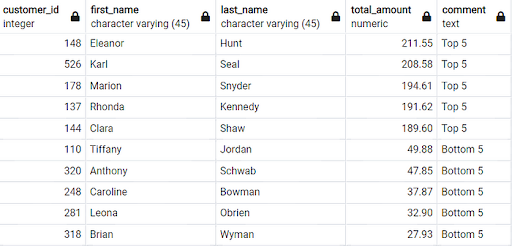
We can also get the above query result using window functions. Below is the official documentation on window functions.
To find the top and bottom five customers who generated the most revenue using window functions, we’ll
First, create a CTE named total_amt_rank by:
- Joining the
customerandrentaltables usingcustomer_id. - Joining the resultant table with
paymenttable usingrental_id. - Computing the total amount paid by customers for each rental transaction (as
total_amount) grouping bycustomer_id. - Finally, selecting the
customer_id,first_name,last_name,total_amountand rank oftotal_amount(astotal_amount_rank) by sorting it in descending order. This gives rank one to the highest amount and so on.
Select the top five customers by revenue by selecting the customers whose total_amount_rank is between 1-and-5 from the above CTE.
Then, select the bottom five customers by revenue from the above CTE by:
- Sorting
total_amount_rankin thetotal_amt_rank(CTE result) in descending order. - Limiting the result to the first five records.
Merge the above two results using UNION.
WITH total_amt_rank AS
(
SELECT
c.customer_id,
c.first_name,
c.last_name,
SUM(p.amount) AS "total_amount",
RANK() OVER (ORDER BY SUM(p.amount) DESC) AS total_amount_rank
FROM customer c
INNER JOIN rental r
USING (customer_id)
INNER JOIN payment p
USING (rental_id)
GROUP BY c.customer_id
)
(
SELECT *
FROM total_amt_rank
WHERE
total_amount_rank BETWEEN 1 AND 5
)
UNION
(
SELECT *
FROM total_amt_rank
ORDER BY total_amount_rank DESC
LIMIT 5
)
ORDER BY total_amount_rank;
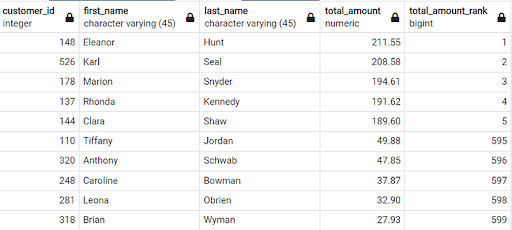
3. Top 5 Countries With the Highest Rentals
In this example, we need to find the top five countries with the highest rentals. For this, we’ll:
- Join the
countryandcitytables usingcountry_id. - Join the resultant table with
addresstable usingcity_id. - Join the resultant table with the
customertable usingaddress_id. - Join the resultant table with the
rentaltable usingcustomer_id. - Count the
country_id(asrental_count) by groupingcountry_id. We may also userental_idto getrental_count. - Sort the result by
rental_countin descending order. - Limit the results to five records.
SELECT
co.country_id,
co.country,
COUNT(co.country_id) AS rental_count
FROM country co
INNER JOIN city ci
USING (country_id)
INNER JOIN address a
USING (city_id)
INNER JOIN customer cu
USING (address_id)
INNER JOIN rental r
USING (customer_id)
GROUP BY co.country_id
ORDER BY
COUNT(co.country_id) DESC
LIMIT 5;

There are a few addresses and cities with no customers. Using INNER JOIN omits such records. In the below query, we’ll look at how the result will include addresses without customers on using left join.
4. Cities and Addresses With No Customers
There are a few cities and addresses without any customers. these may be store addresses. Using INNER JOIN would have omitted them from the results, as there are no matching entries in the other table. For example, a city named London in Canada has no matching city_id in the address table. Using INNER JOIN would have omitted London in Canada from the result. Similarly, four addresses in Canada and Australia have no matching address_id in the customer table.
SELECT
co.country,
ci.city,
a.address,
cu.customer_id
FROM country co
LEFT JOIN city ci
USING (country_id)
LEFT JOIN address a
USING (city_id)
LEFT JOIN customer cu
USING (address_id)
WHERE cu.address_id IS NULL;

5. Countries With No Customers
In this example, we’ll find the countries with no customers.
First, we’ll create a subquery to find the countries with at least one customer by:
- Joining the
countrytable withcitytable usingcountry_id. - Joining the remainder table with
addresstable usingcity_id. - Joining the remainder table with
customertable usingaddress_id.
Select country from countrytable where country_idis not present in the country_idof the above subquery.
SELECT
country
FROM country
WHERE country_id
NOT IN
(
SELECT
co.country_id
FROM country co
INNER JOIN city ci
USING (country_id)
INNER JOIN address a
USING (city_id)
INNER JOIN customer
USING (address_id)
);

6. Are There Any Stores in Australia?
In the above example, we saw that Australia has no customers. In this example, we’ll see are there any stores in Australia by:
- Joining the
countrytable withcitytable usingcountry_id. - Joining the resultant table with
addresstable usingcity_id. - Joining the resultant table with
storetable usingaddress_id. - Selecting records where
store_idIS NOT NULL in Australia.
LEFT JOIN ensures that countries with no cities and cities with no stores are also included in the query result.
SELECT
st.store_id,
co.country,
ad.address
FROM country co
LEFT JOIN city ci
USING (country_id)
LEFT JOIN address ad
USING (city_id)
LEFT JOIN store st
USING (address_id)
WHERE
(st.store_id IS NOT NULL)
AND
(co.country = 'Australia');
There is one store in Australia. In fact, there are just two stores in the whole database. We’ll view them using the below query.
SELECT * FROM store;
7. Languages With No Films
In this example, we’ll see if there are any languages with no films by:
- Joining the
languagetable withfilmtable usinglanguage_id. The left join ensures languages without any films are also includes. - Filtering records where
film_idIS NULL.
SELECT
*
FROM language l
LEFT JOIN film f
USING (language_id)
WHERE f.film_id IS NULL;

We see a few languages with no films in the database. We’ll make sure that it’s not an error by selecting the films with language_id in (2,3,4,5,6) from the film table. The query result should return no records.
SELECT
*
FROM film
WHERE language_id IN (2,3,4,5,6);
8. Popularity of Films by Category in India
In this example, we’ll find the number of rentals per film category in India by joining the required tables as discussed in the earlier examples and by:
- Grouping by
countryandcategoryand filtering records from India and counting the film category name (asfilm_category_count). - Ordering the result by country in ascending order and
film_category_countin descending order.
SELECT
co.country,
cat.name AS film_category,
COUNT(cat.name) AS film_category_count
FROM country co
INNER JOIN city ci
USING (country_id)
INNER JOIN address ad
USING (city_id)
INNER JOIN customer cu
USING (address_id)
INNER JOIN rental re
USING (customer_id)
INNER JOIN inventory inv
USING (inventory_id)
INNER JOIN film fi
USING (film_id)
INNER JOIN film_category fc
USING (film_id)
INNER JOIN category cat
USING (category_id)
/*
Using
WHERE co.country = 'India'
here, instead of
HAVING co.country = 'India'
reduces the query execution time.
*/
GROUP BY (co.country, cat.name)
HAVING co.country = 'India'
ORDER BY
co.country ASC,
COUNT(cat.name) DESC;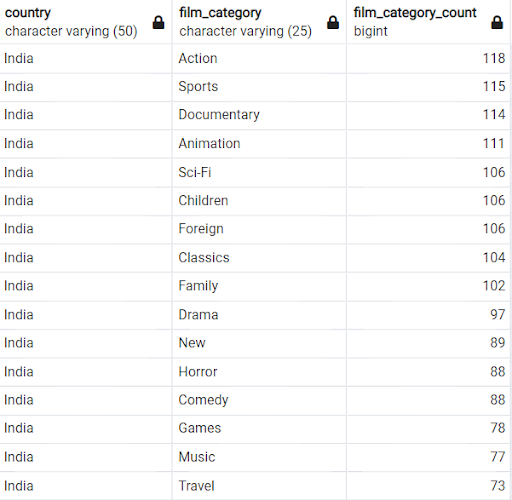
9. Films With Only a Single Actor
In this example, we‘ll find the films with a single actor by:
- Joining the
filmtable withfilm_actortable usingfilm_id. - Grouping by
film_idand counting the number of actors (asactor_count). - Filtering records where
actor_countis 1.
SELECT
f.film_id,
f.title,
COUNT(fa.actor_id) AS actor_count
FROM film f
INNER JOIN film_actor fa
USING (film_id)
GROUP BY f.film_id
HAVING COUNT(fa.actor_id) = 1;
10. Number of Films of an Actor By Category
In this example, we’ll find the number of films of an actor by film category by:
- Creating a CTE named
actor_cat_cntthat returns the number of films for eachactor_idandcategory_id. - Joining the above CTE with
categorytable usingcategory_id. - Joining the resultant table with
actortable usingactor_id. - Sort actor name (concatenation of
first_nameandlast_name) in ascending order andfilm_countin descending order.
WITH
actor_cat_cnt AS
(
SELECT
fa.actor_id,
fc.category_id,
COUNT(f.film_id) AS film_count
FROM film_actor fa
INNER JOIN film f
USING (film_id)
INNER JOIN film_category fc
USING (film_id)
GROUP BY
fa.actor_id,
fc.category_id
)
SELECT
CONCAT(ac.first_name, ' ', ac.last_name) AS actor,
ca.name AS category,
film_count
FROM actor_cat_cnt
INNER JOIN category ca
USING (category_id)
INNER JOIN actor ac
USING (actor_id)
ORDER BY
CONCAT(ac.first_name, ' ', ac.last_name) ASC,
film_count DESC;

11. Popular Categories of an Actor
In the above example, we found the number of films of an actor by film category. In this example, we’ll find the popular categories of an actor (i.e. the categories in which an actor has the most films) by
- Creating a CTE named
actor_cat_cntthat returns the number of films for eachactor_idandcategory_idand rank the categories of each actor by the count of films in descending order (ascat_rank). - Joining the above CTE with
categorytable usingcategory_id. - Joining the resultant table with
actortable usingactor_id. - Filtering the records with
cat_rank = 1. - Sort actor name (concatenation of
first_nameandlast_name) in ascending order andfilm_countin descending order.
WITH
actor_cat_cnt AS
(
SELECT
fa.actor_id,
fc.category_id,
COUNT(f.film_id) AS film_count,
RANK() OVER
(PARTITION BY fa.actor_id
ORDER BY COUNT(f.film_id) DESC) AS cat_rank
FROM film_actor fa
INNER JOIN film f
USING (film_id)
INNER JOIN film_category fc
USING (film_id)
GROUP BY
fa.actor_id,
fc.category_id
)
SELECT
CONCAT(ac.first_name, ' ', ac.last_name) AS actor,
ca.name AS category,
film_count
FROM actor_cat_cnt
INNER JOIN category ca
USING (category_id)
INNER JOIN actor ac
USING (actor_id)
WHERE cat_rank = 1
ORDER BY
CONCAT(ac.first_name, ' ', ac.last_name) ASC,
film_count DESC;

This brings this article to an end. We’ve discussed ways of merging tables by rows or columns using SQL along with a few examples using the dvd_rental database. These are the fundamental concepts that are used in almost every query we write in SQL. We may not frequently use a few of them in practice, but knowing them is necessary.
Frequently Asked Questions
How do you merge two tables in SQL?
Multiple tables can be merged by columns in SQL using joins, which merges them based on the specified columns. It requires the primary key of one table and a foreign key of the other to execute.
How do you merge two tables in SQL by columns.
There are eight common commands that allow you to merge two tables by columns, including:
- INNER JOIN
- LEFT JOIN
- RIGHT JOIN
- FULL JOIN
- CROSS JOIN
- SEMI JOIN
- ANTI JOIN
- SELF JOIN
How do you merge two tables in SQL by rows?
You can merge two tables in SQL by row using the following commands:
- UNION
- UNION ALL
- INTERSECT
- EXCEPT





